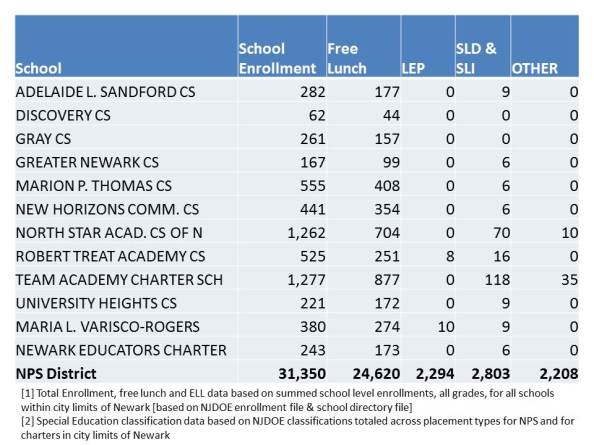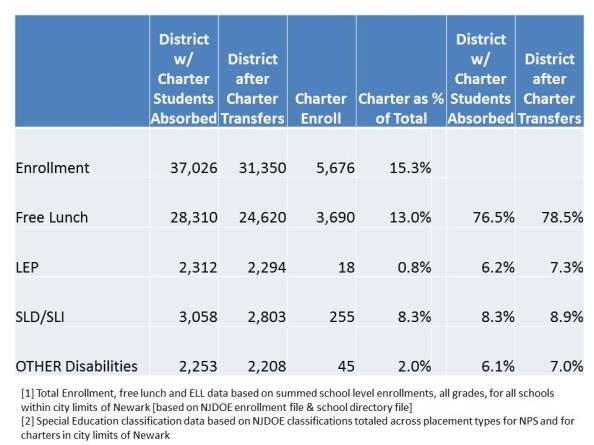Effects of Charter Enrollment on Newark District Enrollment
In numerous previous posts I have summarized New Jersey charter school enrollment data, frequently pointing out that the highest performing charter schools in New Jersey tend to be demographically very different from schools in their surrounding neighborhoods and similar grade level schools throughout their host districts or cities. I have tried to explain over and over that the reason these differences are important is because they constrain the scalability of charter schooling as a replicable model of “success.” Again, to the extent that charter successes are built on serving vastly different student populations, we can simply never know (even with the best statistical analyses attempting to sort out peer factors, control for attrition, etc.) whether the charter schools themselves, their instructional strategies/models are effective and/or would be effective with larger numbers of more representative students.
Here, I take a quick look at the other side of the picture, again focusing on the city of Newark. Specifically, I thought it would be interesting to evaluate the effect on Newark schools enrollment of the shift in students to charter schools, now that charters have taken on a substantial portion of students in the city. If charter enrollments are – as they seem to be – substantively different from district schools enrollments, then as those charter populations grow and remain different from district schools, we can expect the district schools population to change. In particular, given the demography of charter schools in Newark, we would expect those schools to be leaving behind a district of escalating disadvantage – but still a district serving the vast majority of kids in the city. I’m not sure why I never got around to looking this issue. I’ve certainly explored it in Pennsylvania with respect to special education populations (where there exists an incentive for PA charters to serve low need special education students, leaving high need ones behind for the district to serve with fewer resources).
First, here are the data sources on which I am relying for this analysis:
1) school level enrollment data 2010-11: http://www.nj.gov/education/data/enr/enr11/stat_doc.htm
2) school directory (for identifying city location): http://education.state.nj.us/directory/schoolDL.php
3) special education classification & placement:http://www.nj.gov/education/specialed/data/ADR/2010/EligibilitybyPlacement/PlacementByElig6-21.xls
[Placement by eligibility 6 to 21 year olds. I left of 3 to 5 year olds for now]
This is a rough first cut at an analysis that should be done in greater depth at some point and for more than just Newark. Consider this to be illustrative.
Here’s my usual starting point – % free lunch and % ell by school for schools with their city of location as Newark.
 Again, most of the charter schools in Newark have very low % Free Lunch or % ELL when compared with other schools in Newark, except for a handful of NPS specialized and magnet schools. Indeed, the district does impose a significant degree of segregation on itself.
Again, most of the charter schools in Newark have very low % Free Lunch or % ELL when compared with other schools in Newark, except for a handful of NPS specialized and magnet schools. Indeed, the district does impose a significant degree of segregation on itself.
The real trick in all of this is to figure out how to balance the presence of these specialized schools, charter schools and district schools to create the best set of opportunities for the largest share of children.
If we take the school level enrollments for charter schools in Newark and for NPS schools in Newark and sum them up we get the following distribution of students:
Table 1. Summed School Level Enrollments* from Enrollment File
SLI = speech/language impairment, SLD = specific learning disability.
*Note that if we look at the district enrollment data, NPS enrollment is actually greater than the figure above, and greater in each other category. Some of the difference is a function of special education out of district placements, where many of those students are both disabled and low income. District reported totals are enrollment = 33,279, free lunch = 26,320, ELL = 2,665 (leading to slightly higher disadvantaged shares than above). see: http://www.nj.gov/cgi-bin/education/data/enr11plus.pl
A noticeable feature of Table 1 is that for the most part, charter schools aren’t serving many children with disabilities to begin with. But, they are especially not serving children with disabilities other than mild specific learning disabilities or speech/language impairment.
Table 2 puts Table 1 into percentages.
Table 2. District school and charter school enrollment characteristics by percent
Here, we see that few charters in Newark have anywhere near the % free lunch share of the district as a whole. The differences are especially large for Robert Treat, North Star and Greater Newark. The differences are even more striking for LEP and special education classifications, except for TEAM which enrolls a sizable share of SLD/SLI students, but very few more severe disabilities.
Now, here’s another angle on the student populations. Table 3 shows the effect of extracting these charter enrollments from the district enrollments. In the first column, I include the summed enrollments of all schools in the city of Newark including charter schools (but not private schools). In the second column I include the summed enrollments of Newark Public schools within the city of Newark.
The fourth column is particularly important. This column shows that:
- Charter schools listed above have absorbed about 15% of the district total enrollment.
- But, these charter schools have absorbed only 13% of the district’s lowest income children.
- Further, they have absorbed less than 1% of the district’s ELL population.
- They have absorbed only 8.3% of the district’s low need special education population
- And, they have absorbed only 2% of the district’s higher need special education population (most of these being students listed in the broad, “other health impairment” category and attending TEAM academy).
For charter schools not be be having a negative effect on district enrollment characteristics, they would have to be – in the aggregate – absorbing 15% of each special needs group. But clearly they are not. Thus, we can expect that those left behind in district schools are becoming a higher and higher need group as charter enrollments expand (unless they become more representative in the aggregate).
Table 3. District & Charter Enrollments & Effect of Charter Enrollments on District
- Thus far, growth in enrollment of the charters included here has led to an increase in district schools % free lunch of 2%.
- Thus far, growth in enrollment of the charters included here has led to an increase in the district schools % ELL of greater than 1% (given that the rate is only around 7%, this is sizable).
- Charter enrollment growth has also led to growth in concentrations of children with lower and especially higher cost disability classifications.
Again – this is just a cursory, preliminary cut at these data based on simply summing up the available enrollment data from 2010 and 2011.
There are numerous potential additional complexities here. For example, does the presence of some high flying charters keep some families in the district that might otherwise seek to move elsewhere? That is, if the charters weren’t there, would the district lose less needy students to out-migration? That’s possible, but likely in smaller shares than seen here.
My main point here is that this is yet another issue of New Jersey charter schooling that requires much more in-depth investigation… with improved data on specific student level mobility… and also exploring the effect of charter enrollment attrition mid-year on nearby school population characteristics.
These issues are particularly worthy of additional exploration as NJDOE considers massive charter expansion in other cities such as Camden. Again, if the successes of some of these charters are largely contingent on the selective populations they serve, the successes of these charters (a) may be limited in their replicability and b) may be coming at significant expense to other children left behind.
Further, these issues are of critical importance when determining the appropriate approach to financing charter schools and their host districts. As I have noted previously, Pennsylvania has chosen among the worst approaches for dealing with special education charter school financing. New Jersey must avoid a comparable debacle (and thus far, has largely done so). All student needs based funding must be distributed with respect to the actual needs of students served – especially in the case of children with disabilities. That is, if a charter school serves a district student with a mild, specific, low cost disability, they should be subsidized specifically on that basis, so as to ensure that sufficient funding is left for the district to serve remaining higher need students. New Jersey charter school financial data continue to be woefully inadequate for detailed analysis. More on that at a later point.
Cheers!
This blog post has been shared by permission from the author.
Readers wishing to comment on the content are encouraged to do so via the link to the original post.
Find the original post here:
The views expressed by the blogger are not necessarily those of NEPC.



